As dawn broke, I was on the freeway, bound for the northeastern corner of Tainan. I then took Road 172 into the hills beyond the hot spring resort of Guanziling (關子嶺).
Tourists have been coming to Guanziling since 1902. Its muddy alkaline sodium bicarbonate waters are said to confer health and beauty benefits on those willing to soak for a while, especially if they don’t wash off the silt particles immediately after getting out of the pool.
My destination was a spot I’ve visited at least half a dozen times, but on this occasion I was determined to complete a short hike I’ve known about for years, but had never gotten around to doing.

Photo: Steven Crook
FIRE, WATER AND MESONA
The Fire and Water Spring (水火同源), sometimes called the Water Fire Cave, is one of handful of locations in Taiwan’s south where natural gas percolates upward through the ground and burns around the clock. It’s 4km beyond the busiest part of Guanziling via Road 172B (172乙), a twisting up-and-down route on which motorists should take special care.
The spring’s flames are far brighter and more consistent than those at Chuhuozi (出火仔, see “Where the fire never goes out,” Taipei Times, May 20, 2022). Yet it’s said that this natural phenomenon was even more impressive before a powerful earthquake ripped through this part of Taiwan in 1964.
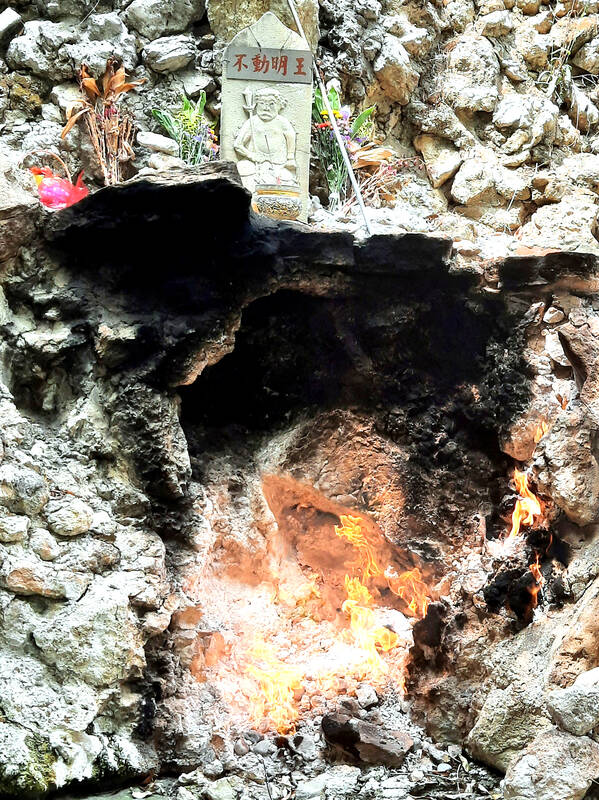
Photo: Steven Crook
In October 2011, a mischievous tourist splashed water on the flames until they went out. The fire almost immediately restarted, however, because the stones around the spring were hot enough to ignite the gas that continued to bubble up. During the 2021 drought, the pool dried up, although the fire kept burning.
There’s no charge for admission or parking at the Fire and Water Spring. All the vendors are gathered under one roof, making the place look tidier than some attractions in Taiwan.
In addition to the usual ice creams and cold drinks, you can buy dried Chinese mesona and treats made with it. Mesona, known to Mandarin speakers as xiancao (仙草), is usually turned into a black jelly-type dessert called xiancao dong (仙草凍). This dish is often translated as “grass jelly,” even though the plant is not a grass but a member of the mint family.
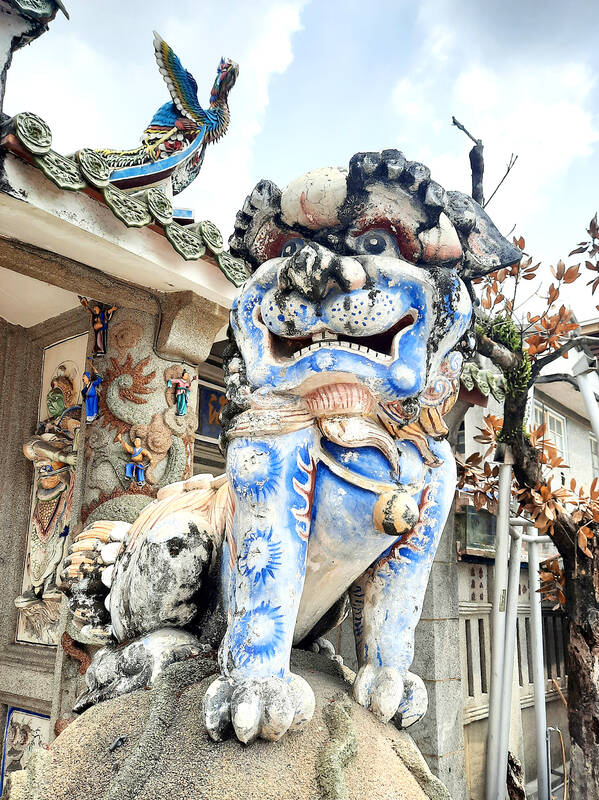
Photo: Steven Crook
Chinese mesona was once a crop of considerable local importance. Between Guanziling and the freeway, there’s a village that gained its name — Xiancaopu (仙草埔) — from the abundance of mesona that grew nearby.
Carrying an umbrella and a bottle of water, I walked past the vendors and the flames. This time, I noticed, there was no offering of bananas in front of the spring’s macaque statue.
DELIGHTFUL TREK
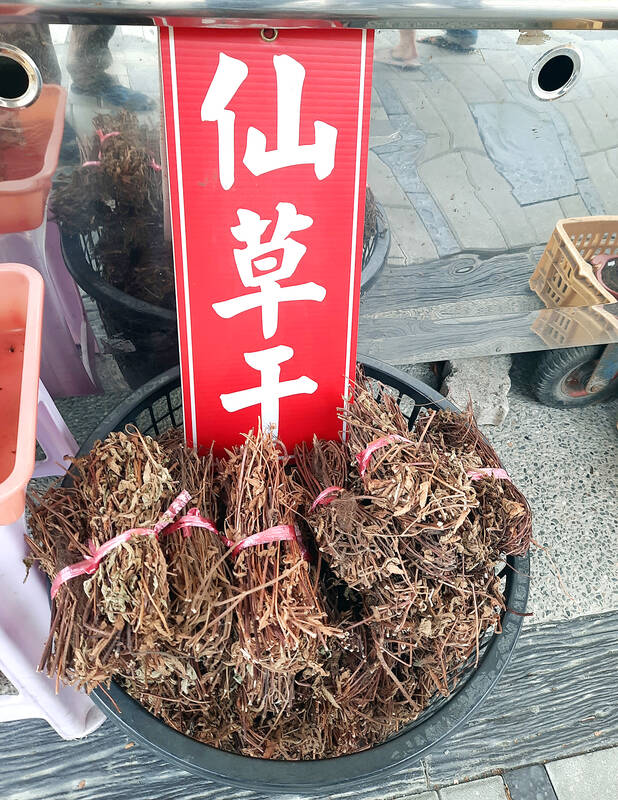
Photo: Steven Crook
Some steps took me up to the road and the start of the 1.3km-long trail to Huoshan Biyun Temple (火山碧雲寺). From pre-hike research, I knew that the trailhead is higher than the shrine (about 480m above sea level, compared to an elevation of 395m for the temple), but that I should expect to ascend before the final downhill stretch.
A few minutes into the hike, I came to a geological surprise. I reached some large chunks of coral limestone, a type of rock I’d previously seen in Kenting National Forest Recreation Area (墾丁國家森林遊樂區) and Kaohsiung’s Shoushan National Nature Park (壽山國家自然公園). It’s evidence that tectonic activity pushed rock layers from the ocean bed to well above sea level.
The path is well maintained and makes for pleasant walking. There’s plenty of shade, and on the day I hiked the mosquitoes weren’t too bad. As well as a few benches along the way, 380 meters from the temple there’s a pavilion with a table.

Photo: Steven Crook
Distance markers and bilingual signs along the way make it impossible to get lost. A side trail leads toward the summit of Pillow Mountain (枕頭山), where there’s a lookout 645m above sea level. I’ve not been able to confirm that this trail is currently passable, but it’s certainly still possible to drive all the way to the top of this mountain.
Near the western end of the spring-to-temple trail, just as the Buddhist complex comes into view, hikers need to negotiate a slippery concrete road. This was the only point where I felt extra caution was needed. Otherwise, it’s a delightful and entirely relaxing walk that takes about 20 minutes one way.
CHARMING TEMPLE
Huoshan Biyun Temple isn’t your run-of-the-mill Taiwanese house of worship, and — what with the fine view over the lowlands — it’s easy to spend an hour or more here. Compared to most shrines, it’s bigger and older. Monks have been living here since 1701, and parts of the main building date from 1808. Guanyin and the Amitabha Buddha are among the deities honored within.
The ornate entrance that faces the main road features charming paintings and carvings. If you’ve hiked from the Fire and Water Spring, to see it you’ll have to go through the complex and outside. It’s more than worth it.
Bilingual information panels around the complex introduce facets of the temple’s history. Only on this most recent visit did I notice a panel which explained the significance of a slab of rock to the right of the main entrance.
Called the Rice Gushing Hole (出米洞), the legend attached to it brings to mind Aesop’s tale of the goose that laid golden eggs. It’s said that a cavity in the rock miraculously spewed enough unhusked grain to sustain the temple’s monks. One night, however, a selfish individual who hoped to take all of the rice for himself hacked away at the rock, after which it provided no more grain.
Worried that the weather might change, I hiked back to the Fire and Water Spring at a good pace. Dripping my way through the parking lot, I looked at my watch. It wasn’t even 9.30am. I still had a whole day of free time ahead of me.
IF YOU GO
GETTING THERE
It’s tricky if you don’t have your own vehicle. The spring and the temple are both served by the #12-2 Yellow Bus, but it runs only on weekends and national holidays. Eight services between 7:50am and 4:25pm follow a clockwise route that begins and ends near Lingding Park (嶺頂公園) in Guanziling. To get to Guanziling, board the #7214 bus in Chiayi. There’s one service per hour between 7am and late afternoon.

US President Donald Trump may have hoped for an impromptu talk with his old friend Kim Jong-un during a recent trip to Asia, but analysts say the increasingly emboldened North Korean despot had few good reasons to join the photo-op. Trump sent repeated overtures to Kim during his barnstorming tour of Asia, saying he was “100 percent” open to a meeting and even bucking decades of US policy by conceding that North Korea was “sort of a nuclear power.” But Pyongyang kept mum on the invitation, instead firing off missiles and sending its foreign minister to Russia and Belarus, with whom it
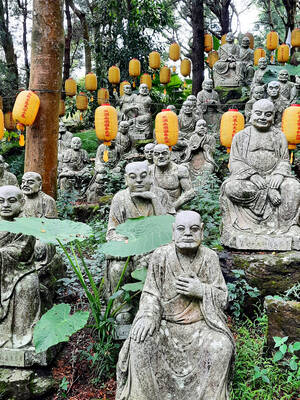
When Taiwan was battered by storms this summer, the only crumb of comfort I could take was knowing that some advice I’d drafted several weeks earlier had been correct. Regarding the Southern Cross-Island Highway (南橫公路), a spectacular high-elevation route connecting Taiwan’s southwest with the country’s southeast, I’d written: “The precarious existence of this road cannot be overstated; those hoping to drive or ride all the way across should have a backup plan.” As this article was going to press, the middle section of the highway, between Meishankou (梅山口) in Kaohsiung and Siangyang (向陽) in Taitung County, was still closed to outsiders
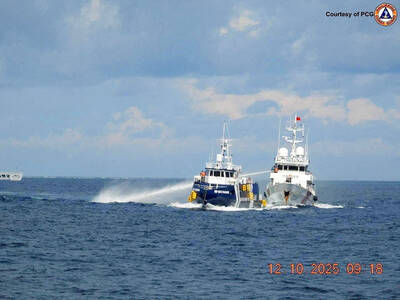
Many people noticed the flood of pro-China propaganda across a number of venues in recent weeks that looks like a coordinated assault on US Taiwan policy. It does look like an effort intended to influence the US before the meeting between US President Donald Trump and Chinese dictator Xi Jinping (習近平) over the weekend. Jennifer Kavanagh’s piece in the New York Times in September appears to be the opening strike of the current campaign. She followed up last week in the Lowy Interpreter, blaming the US for causing the PRC to escalate in the Philippines and Taiwan, saying that as

The Chinese Communist Party (CCP) has a dystopian, radical and dangerous conception of itself. Few are aware of this very fundamental difference between how they view power and how the rest of the world does. Even those of us who have lived in China sometimes fall back into the trap of viewing it through the lens of the power relationships common throughout the rest of the world, instead of understanding the CCP as it conceives of itself. Broadly speaking, the concepts of the people, race, culture, civilization, nation, government and religion are separate, though often overlapping and intertwined. A government